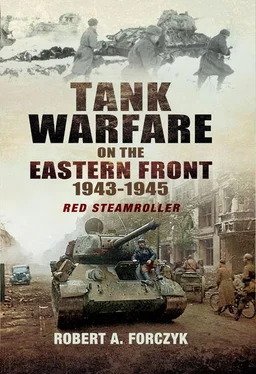Following the repulse of 4 GMC’s breakout attempt, a brief lull settled over the Mius Front, as Tolbukhin regrouped for another offensive. Nehring’s XXIV Panzerkorps arrived in sector and took command over both 16.Panzergrenadier-Division and 23.Panzer-Division, as well as the attached Sturmgeschütz-Abteilungen. Nehring concentrated the remaining 33 tanks and 47 assault guns into mobile reserves to help hold the HKL, which was desperately short of infantrymen. Meanwhile, Hausser’s II.SS-Panzerkorps and the 3.Panzer-Division were en route by rail to make an all-out counter-attack. Hitler decided that he wanted the LSSAH sent to Italy, so Hausser was left only with the Das Reich and Totenkopf . These forces did not arrive in Hollidt’s AOK 6 area until 27–29 July, at which point Hollidt began preparing for his major counter-attack against the bridgehead, designated Operation Roland .
Hollidt’s plan was essentially a broad-frontal attack against the entire perimeter of the Soviet bridgehead, with the main effort against the hills around Stepanovka by Totenkopf , Das Reich and 3.Panzer-Division. Hausser had a total of 119 operational tanks (including about 15 Tigers) and about 30 assault guns in his two divisions, but even after acquiring LSSAH ’s remaining armour when it departed for Italy his formations were about 30 per cent below strength. {142} Generalleutnant Franz Westhoven’s 3.Panzer-Division, which had lost half its armour during Zitadelle , was able to put 37 tanks in the field, mostly Pz IIIs. Nehring’s two divisions would attack from the southwest with a total of 55 tanks, 28 assault guns and 17 Marder tank destroyers. The German XVII and XXIX Armeekorps would each also contribute one infantry division and a few assault guns to make supporting attacks on the flanks. Altogether, AOK 6 was committing five mechanized divisions with almost 300 AFVs against the Mius bridgehead. However, these German divisions could not count upon their traditional help from the Luftwaffe, which had suffered heavy losses during Zitadelle and depleted its limited fuel reserves. Fliegerkorps VIII had lost over 300 aircraft, including more than 50 Ju-87 Stukas, so close air support assets were in particularly short supply. Indeed, Zitadelle cost the Stuka squadrons eight of their best pilots, all holders of the Ritterkreuz des Eisernen Kreuzes . {143}
Tolbukhin’s two mechanized corps had lost a substantial part of their armour during the efforts to break out of the bridgehead, but likely still had about 40– 50 tanks each. Some tank replacements were arriving as well. More importantly, the 2nd Guards Army’s 1st Guards Rifle Corps (1 GRC) had thoroughly fortified the town of Stepanovka and created a dense, three-tiered layer of minefields, covered by multiple anti-tank positions. In addition, the 8 VA was able to provide both fighter cover and close air support to the Soviet defenders.
Operation Roland commenced at 0810 hours on 30 July. Apparently, Hausser’s assault groups attacked with minimal artillery support and no air cover. Totenkopf was the main effort, committing 68 tanks in two columns driving along a ridgeline trail for Hill 213.9, just east of Stepanovka. Brigadeführer Hermann Priess, commander of Totenkopf , put his 10 Tigers in front, leading the advance, which proved to be a mistake on this occasion. About 1,000 metres after crossing their line of departure, the Tigers unexpectedly ran into a dense minefield and seven were quickly immobilized when their tracks were blown off. Intense anti-tank fire from 76.2mm ZIS-3 guns opened up, many from flank positions, and the German tanks were sky-lined on the ridge which made them wonderful targets. [34]Tanaschishin’s remaining T-34s were dug in so that only their turrets could be seen, and most of the ZIS-3 batteries were virtually invisible. Soviet infantrymen, using the PTRD anti-tank rifle, peppered the enemy tanks and forced their commanders to ‘button up’ – which made it very difficult to spot the enemy anti-tank guns. The immobilized Tigers were hit repeatedly and all were soon put out of action (two were later destroyed by their own crews when they could not be recovered). The rest of the Totenkopf ’s panzers and assault guns were also hammered, and despite efforts by the divisional pioniers to breach the minefields, Totenkopf ’s advance was repulsed. Efforts to mass the fire of Totenkopf ’s divisional artillery failed to suppress the Soviet defences, which were difficult to pinpoint. Nor did Das Reich achieve much success, running into dense minefields and anti-tank guns west of Stepanovka, which knocked out 25 of its tanks. Adding to Hausser’s discomfort, Soviet IL-2 Sturmoviks repeatedly attacked German assault formations, with no interference from the Luftwaffe. By mid-afternoon, Das Reich ’s Panzergrenadiers fought their way into the outskirts of Stepanovka, but were fought to a standstill. Similarly, Westhoven’s 3.Panzer-Division lost 18 of its 37 tanks and accomplished little. Amazingly, Hausser’s II.SS-Panzerkorps had lost 73 of its 119 tanks and 12 assault guns on the first day of the operation, as well as suffering 812 casualties – much heavier losses than it had incurred during a similar day of Zitadelle . {144}
Hollidt’s counter-offensive might have collapsed against a wall of Soviet mines and anti-tank guns, had not Nehring’s XXIV Panzerkorps supporting attack achieved some measure of success southwest of Stepanovka. Von Vormann’s 23.Panzer-Division attacked with Kampfgruppe Schägger at 0810 hours. The composition of this Kampfgruppe demonstrates the growing poverty of German Panzer-Divisionen after Zitadelle : Major Peter Schägger’s Panzer-Aufklärungs-Abteilung 23, Hauptmann Robert Alber’s I./Pz.Rgt. 201, the II./Pz.Gren.Rgt. 126 and the Feld-Lehr-Bataillon 128 (the division’s replacement battalion). Despite lacking Tigers like Hausser’s Waffen-SS divisions, both Schägger and Alber were experienced reserve officers who knew how to handle their limited resources. Avoiding high ground, Alber manoeuvred his tanks through lightly-wooded, low-lying ground and managed to overrun the town of Saurivka (Saur-Mogilsky in 1943). Soviet mines and anti-tank guns were a problem in this sector as well, but the 315th Rifle Division’s defences were not as well-prepared. After breaking through the crust, Alber’s panzers boldly advanced cross-country and seized the village of Garany, behind the 315 RD’s main positions. At 1000 hours, the 16.Panzergrenadier-Division joined the attack and sent Kampfgruppe Sander (Panzer-Aufklärungs-Abteilung 116 and III./Grenadier-Regiment 50 from 111.Infanterie-Division) to link-up with Alber’s Panzers, which was achieved at 1145 hours. A force of just five battalions had surrounded the 315 RD and succeeded in taking over 3,000 Soviet prisoners on the first day of Roland , as well as destabilizing the left flank of the Mius bridgehead. {145}
During the night of 30–31 July, Totenkopf ’s pioniers were able to remove about 2,000 mines and cleared a narrow lane through the outer minefields, but pionier casualties for this effort were excessive. On the second day of the offensive, Hausser’s II.SS-Panzerkorps began their attack at 0915 hours with a 45-minute artillery preparation and received some Stuka close air support sorties, but their assault units were substantially weaker. Totenkopf attacked into the teeth of the Soviet defence with only 15 tanks (including two Tigers) and was again repulsed with heavy losses. Both Tigers were knocked out by anti-tank fire. {146} SS-Unterscharführer Rolf Stettner commanded one of Totenkopf ’s advancing tanks:
Читать дальше








![John Stieber - Against the Odds - Survival on the Russian Front 1944-1945 [2nd Edition]](/books/405234/john-stieber-against-the-odds-survival-on-the-russian-front-1944-1945-2nd-edition-thumb.webp)



